|
Messerschmitt Bf 108
ProfiPACK
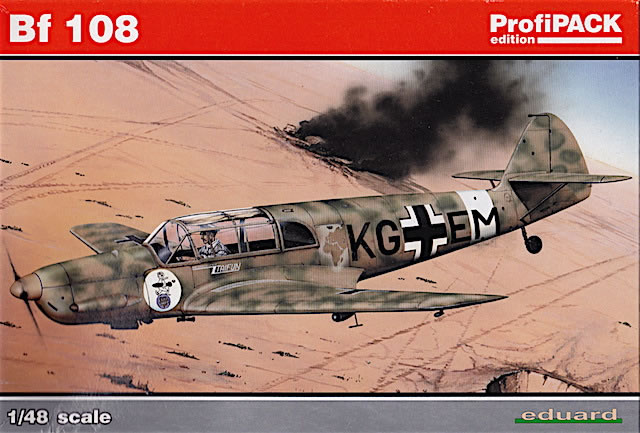
Eduard, 1/48 scale
S u m m a r y : |
Catalogue Number: |
Eduard Kit No. 8078 – Bf 108 Profipack |
Scale: |
1/48 |
Contents & Media: |
Approx. 87 grey plastic parts (6 unused); 2 clear plastic parts; one fret of pre-painted photo-etched brass; one sheet of pre-cut canopy masks; one decal sheet with markings and stencils for five aircraft; 12 page A5 assembly instruction booklet with full-colour painting and marking guide with four view drawings of each aircraft. |
Price: |
USD $34.95 available online from Eduard’s website; also available from specialist hobby retailers worldwide.
Currently on sale at Squadron for USD$23.07 plus shipping. |
Review Type: |
First Look |
Advantages: |
Sound basic kit; clear instructions; interesting marking schemes. |
Disadvantages: |
Nothing significant. |
Conclusion: |
A comprehensive repackaging of one of Eduard’s older but solid kits that, with care, can be built into a great-looking model. The plastic parts are well moulded, and nicely complemented by the photo-etched parts and variety of marking options. If don’t already have one of Eduard’s 1/48 Bf 108 kits, you should seriously consider this boxing; if you do have one, still take a look because there are some great marking choices here. |
Reviewed by
Brad Fallen

Eduard's 1/48 scale Bf 108
is available online from Squadron.com for only USD$23.07!
The Messerschmitt Bf 108 Taifun first flew in 1934 and entered production the following year. More than 700 of the main variant, the Bf 108 B, were built for the Luftwaffe before production ceased in 1944. However the assembly line, which by this time was in France, survived the war and was re-opened to produce nearly 300 more machines as ‘Nord 1000s’.
The Taifun’s family connection to the Bf 109 is unmistakable. The Bf 108’s narrow track undercarriage, leading-edge slats, tail surfaces and – to an extent – overall silhouette were all inherited by the younger fighter. And like its sibling the Bf 108 was flown by a wide range of operators in many different colour schemes, notwithstanding its vastly lower production numbers.
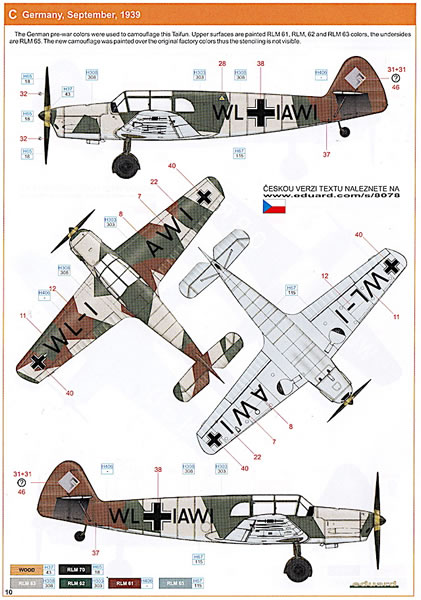
This variety of markings, along with its graceful lines and significance as a Luftwaffe liaison aircraft, makes the Bf 108 an attractive modelling subject. However it hasn’t been widely kitted: in 1/72 there is Heller’s 1970s product, a much more recent effort from Fly, and possibly other kits I haven’t been able to find. There appears to be nothing at all in 1/32, but again I may have missed something. Fortunately this dearth doesn’t really matter, because in 1/48 we have Eduard’s gem.
Eduard released its 1/48 Bf 108 B back in 2002. Brett reviewed and built the kit here shortly afterwards, concluding that the kit was “a quick and enjoyable project” and that “the comprehensive engine and cabin detail, straight from the box, is very impressive”. Brett did find some aspects of the kit challenging – for example alignment of the fuselage and wing assemblies – but his build review includes a number of points to help modellers avoid these problems.
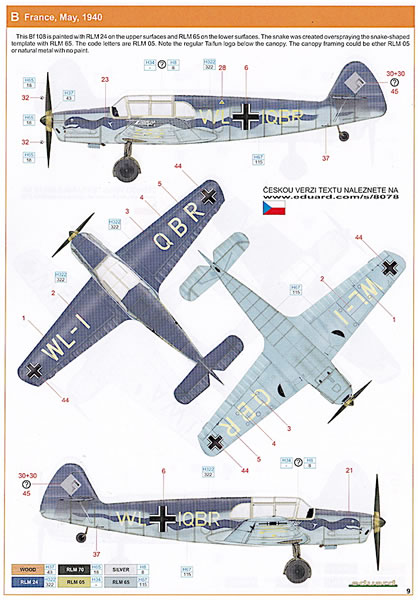
Eduard has subsequently re-released the kit a number of times, including two further Profipack boxings (2002 and 2009) and three Weekend Editions (2004, 2006, and 2010). Mick Evans reviewed the 2009 Profipack and, like Brett, has built the kit and regards it highly. I bought the same edition from my local hobby shop soon after it was released and was impressed by the levels of detail, encouraging test fit and Eduard’s marking choices, which included four German and one Yugoslav Bf 108.
Now Eduard has released a new Profipack version, which features the same box art as the original 2002 release – a Bf 108 of Sonderkommando Blaich flying over a desert battlefield.
The Bf 108 wasn’t a complex aircraft, and this simplicity is reflected in the kit’s comparatively low parts count: less than 90 parts on three dark grey sprues. The moulds for this kit are now 14 years old, and the parts aren’t as refined as those in Eduard’s current generation of kits, they’re still very good. Surface detail is reasonably fine, there is only a little flash here and there, and no sink marks that I could find.
One area where the kit shows its age a little is in its fixed control surfaces and leading edge slats. In contrast with Eduard’s newer Bf 109 kits, these are moulded in the neutral position as part of the wings and tailplanes. The exception here is the rudder, which is moulded in two halves and presents one of the kit’s few building options, with a different version used on the Sonderkommando Blaich machine.
More than a quarter of the plastic parts go towards making up the Taifun’s Argus As 10 engine. While the finished engine will be largely hidden beneath the fuselage halves, enough can be seen to make it worth spending a bit of time on.
The cockpit is also well appointed, but here the plastic is supplemented with some lovely pre-painted photo-etch.
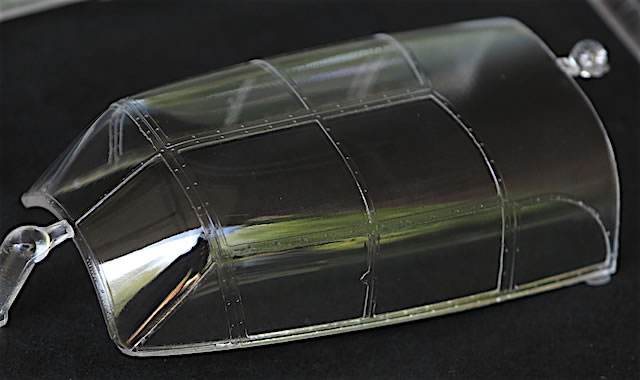
Most of this is used for the seat harnesses, instrument panel and cockpit sidewalls; the latter two feature some very fine instrument details that should be quite visible through the large canopy.
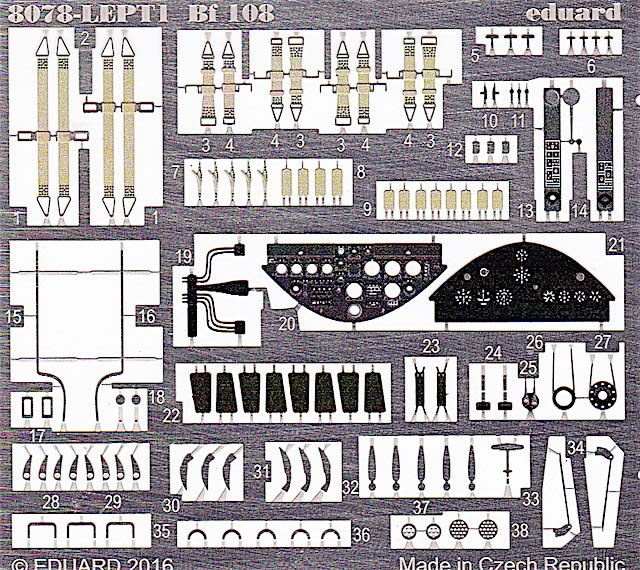
The canopy itself is a single-piece moulding that is thin, clear and with well-defined frames. These, along with the supplied pre-cut masks, should make preparation for painting straightforward.
A number of the other photo-etched parts – this time unpainted – represent aileron, elevator and rudder linkages. These are small and will be fiddly to assemble, but if installed with patience will deliver a good-looking result.
As usual with Eduard, the assembly instructions are clearly drawn and logically sequenced. To ensure everything lined up I’d probably attach the horizontal stabilisers after attaching the wings, rather than before as suggested in the instructions, but this is just my personal preference.
The instructions include full-colour, four view drawings of the five marking options. Gunze Sangyo paint numbers are used for colour call-outs here and throughout the assembly process.
The decal sheet has been produced by Eduard and is quite large for a kit of this size – reflecting the variety of featured markings.
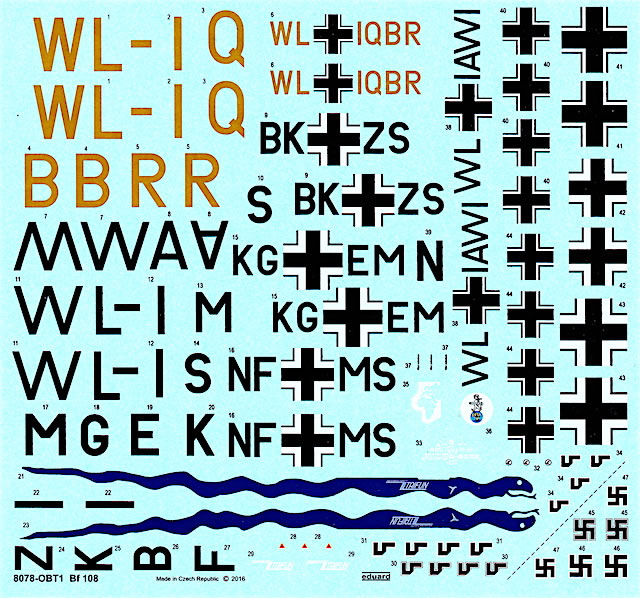
The decals are generally well printed, although I noticed a little bit of bleed-through on one of the crosses, and the yellow serial letters for marking option B have a slightly darker border that may or may not be visible after application.
Markings
The Bf 108 served the Luftwaffe in a number of theatres and roles before and during World War II, and this breadth of service is reflected in the marking options.
The featured aircraft are:
-
KG+EM of Sonderkommando Blaich, Libya, 1942. Eduard’s colour call outs for this aircraft are RLM 79 Sand Brown and RLM 70 Black Green upper surfaces over RLM 76 Light Blue. However, I’m wondering if this is right: given the theatre of operations, should the RLM 70 and RLM 76 be replaced with RLM 80 Olive Green and RLM 65 Light Blue or RLM 78 Himmelblau respectively? Whatever colours you use, this scheme will look striking with its colourful unit emblem and map of Africa on the port fuselage.
-
WL+QBR, France, May 1940. RLM 24 Dark Blue over RLM 65 Light Blue. This aircraft is even more spectacular, with its yellow-gold serials and large RLM 24 snakes slithering down each side of the fuselage. The main challenge here will be to match the topside RLM 24 with the snake decals, given that the latter appear to have been created by masking off the snake pattern and over-spraying it with RLM 65.
-
WL+IAWI, Germany, September 1939. RLM 61 Dark Brown, RLM 62 Green and RLM 63 Light Grey over RLM 65. As good as the previous two schemes are, this one is probably my favourite: I love the look of the Luftwaffe’s pre-war tricolour splinter scheme, and WL+IAWI wears it to perfection.
-
BK+ZS, Hungary 1942-44. RLM 74 Grey Green and RLM 75 Grey Violet over RLM 76. Much more subdued in its mid-war greys, BK+ZS will nonetheless make an eye-catching model as this is not a scheme commonly associated with the Bf 108.
-
NF+MS, Eastern Front 1942-43. RLM 70 and RLM 71 Dark Green oversprayed with white distemper, over RLM 65. At first glance the plainest Bf 108 of the bunch, NF+MS presents a great challenge for modellers interested in recreating a weathered winter distemper finish – again, a scheme you don’t frequently link with the Taifun.
This package comprehensively revamps of one of Eduard’s older but solid kits that, with care, can be built into a great-looking model. The plastic parts are well moulded, and nicely complemented by the photo-etched parts and variety of marking options. If don’t already have one of Eduard’s 1/48 Bf 108 kits, you should seriously consider this boxing; even if you do have one, still take a look because there are some seriously good marking choices here.
References
Thanks to Eduard for the sample.
Review Text Copyright © 2016 by Brad Fallen
Page Created 6 April, 2016
Last updated
6 April, 2016
Back to HyperScale Main Page
Back to Reviews Page

|
